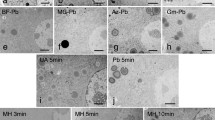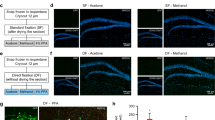Abstract
THE dilemma of enzyme histochemistry is that if the tissue is not fixed, to avoid denaturation, the enzymes may dissolve out of the section into the incubation medium but, conversely, if the tissue is fixed to stop such loss of soluble enzymes, the fixation will inhibit activity and cause generalized denaturation. Thus, for most enzymes, it is argued that too much of the ‘soluble’ or lyo-form of otherwise bound enzymes1 will be lost from unfixed sections during incubation in an aqueous medium; consequently it is considered advisable to fix the tissue prior to such incubation1–3. Although it is usually conceded that the histochemistry of dehydrogenases depends on the use of unfixed sections, some4 have argued that even these should be studied in fixed tissue. Consequently it follows that the scientific basis of enzyme histochemistry must remain uncertain as long as a considerable loss of the activity to be investigated must be expected, whether this is caused by solution into the medium from unfixed sections, or from inhibition of activity produced by the preparative procedures.
This is a preview of subscription content, access via your institution
Access options
Subscribe to this journal
Receive 51 print issues and online access
$199.00 per year
only $3.90 per issue
Buy this article
- Purchase on Springer Link
- Instant access to full article PDF
Prices may be subject to local taxes which are calculated during checkout
Similar content being viewed by others
References
Nachlas, M. M., Prinn, W., and Seligman, A. M., J. Biophys. and Biochem. Cytol., 2, 487 (1956).
Barka, T., and Anderson, P. J., Histochemistry, 207 (Harper and Row, Publishers, Inc., 1963).
Burstone, M. S., Enzyme Histochemistry, 267, 277 (Academic Press, 1962).
Pearse, A. G. E., Histochemistry, 872, 881, 886, 896 (J. and A. Churchill, Ltd., 1960).
Barka, T., and Anderson, P. J., Histochemistry, 316 (Harper and Row, Publishers, Inc., 1963).
Jones, G. R. N., Maple, A. J., Aves, E. K., Chayen, J., and Cunningham, G. J., Nature, 197, 568 (1963).
Jones, G. R. N., Proc. Biochem. Soc. (May 1965).
Gahan, P. B., and Kalina, M., Proc. Biochem. Soc. (May 1965).
Chayen, J., Bitensky, L., Aves, E. K., Jones, G. R. N., Silcox, A. A., and Cunningham, G. J., Nature, 195, 714 (1962). Bonham, D. G., and Gibbs, D. F., Brit. Med. J., ii, 823 (1962). Bonham, D. G., Triangle, 6, 157 (1964). Nerdrum, H. J., Scand. J. Clin. and Lab. Invest., 16, 565 (1964).
Jones, G. R. N., Stain Technol., 39, 155 (1964).
Sloane-Stanley, G. H., and Jones, G. R. N., Biochem. J., 88, 16P (1963).
Chayen, J., and Miles, U. J., Quart. J. Micro. Sci., 94, 29 (1953); Stain Technol., 29, 33 (1954). Chayen, J., Exp. Cell. Res., 20, 150 (1960).
Novikoff, A. B., Symp. Soc. Exp. Biol., 10, 92 (1957).
Author information
Authors and Affiliations
Rights and permissions
About this article
Cite this article
ALTMANN, F., CHAYEN, J. Retention of Nitrogenous Material in Unfixed Sections during Incubation for Histochemical Demonstration of Enzymes. Nature 207, 1205–1206 (1965). https://doi.org/10.1038/2071205a0
Published:
Issue Date:
DOI: https://doi.org/10.1038/2071205a0
This article is cited by
-
In situ determination of different dehydrogenase activity profiles in the linings of odontogenic keratocysts and radicular cysts
The Histochemical Journal (1996)
-
A re-evaluation of the tissue distribution and physiology of xanthine oxidoreductase
The Histochemical Journal (1994)
-
Quantitative comparison between the gel-film and polyvinyl alcohol methods for dehydrogenase histochemistry reveals different intercellular distribution patterns of glucose-6-phosphate and lactate dehydrogenases in mouse liver
The Histochemical Journal (1994)
-
Changes in acid phosphatase activity in rat liver after ischemia
Histochemistry (1989)
-
Polyvinyl alcohol and other tissue protectants in enzyme histochemistry: A consumer's guide
The Histochemical Journal (1989)
Comments
By submitting a comment you agree to abide by our Terms and Community Guidelines. If you find something abusive or that does not comply with our terms or guidelines please flag it as inappropriate.



